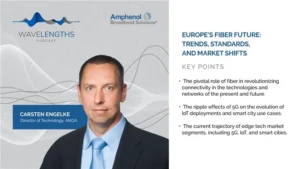Holographic Technology Expands its Application Possibilities: CES 2020
On day one of CES 2020, Daniel Litwin, the Voice of B2B, checked in with Andy Travers, CEO, Ceres Holographics, to learn more about the innovative solutions and business opportunities hologram technology provides. Travers began his journey with Ceres focused on the commercial side of holographic technology, and preparing this technology for new markets, i.e., the transportation industry. Ceres design an adaptable, holographic process for use in the cars of today and tomorrow.
The evolving technology from the traditional surface relief hologram, used in credit cards, to volume holography allows for a wide range of display applications, like automobile windscreens, because it removes the rainbow effect. While Ceres’ primary focus is on holographic technology, they realized the importance of system design as well. “Our team is not just holographers. We’ve got system optical designers, computational people,” said Travers. “we’re even extending our resources to do the content, because with the content you need to know how the hologram and the system works so you know what content you can generate, in real-time, when you’re driving a car.”
Two types of holographic display technologies in use now are transparent displays, built into the car windshield, and augmented reality HUDs. Transparent displays can reduce dashboard clutter and be used with side mirrors as well. Augmented reality HUDs have an extended projection range with a multitude of potential information and advertising capabilities. Travers said as the demand for smartphone use in automobiles increases, the need for holographic technology to display that information will make it a ‘must-have’ for consumers.
For the latest news, videos, and podcasts in the Software & Technology Industry, be sure to subscribe to our industry publication.
Follow us on social media for the latest updates in B2B!
Twitter – @TechMKSL
Facebook – facebook.com/marketscale
LinkedIn – linkedin.com/company/marketscale








